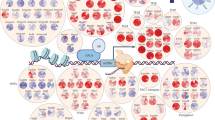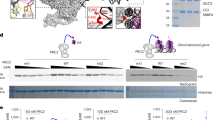Abstract
Increased histone acetylation has been associated with activated gene transcription and decreased acetylation with repression. However, there is a growing number of genes known, which are downregulated by histone deacetylase (HDAC) inhibitors through unknown mechanisms. This study examines the mechanism by which the mouse mammary tumor virus (MMTV) promoter is repressed by the HDAC inhibitor, trichostatin A (TSA). We find that this repression is transcriptional in nature and that it occurs in the presence and absence of glucocorticoids. TSA decreases MMTV transcription at a rapid rate, reaching maximum in 30–60 min. In contrast with previous reports, the repression does not correlate with an inhibition of glucocorticoid-induced nuclease hypersensitivity or NF1-binding at the MMTV promoter. Surprisingly, TSA does not induce sizable increases in histone acetylation at the MMTV promoter nor does it inhibit histone deacetylation, which accompanies deactivation of the glucocorticoid-activated MMTV promoter. Repression of MMTV transcription by TSA does not depend on the chromatin organization of the promoter because a transiently transfected MMTV promoter construct with a disorganized nucleoprotein structure was also repressed by TSA treatment. Mutational analysis of the MMTV promoter indicates that repression by TSA is mediated through the TATA box region. These results suggest a novel mechanism that involves acetylation of nonhistone proteins necessary for basal transcription.
This is a preview of subscription content, access via your institution
Access options
Subscribe to this journal
Receive 50 print issues and online access
$259.00 per year
only $5.18 per issue
Buy this article
- Purchase on Springer Link
- Instant access to full article PDF
Prices may be subject to local taxes which are calculated during checkout








Similar content being viewed by others
References
Alland L, Muhle R, Hou HJ, Potes J, Chin L, Schreiber-Agus N and DePinho RA . (1997). Nature, 387, 49–55.
Allfrey VG, Faulkner R and Mirsky AE . (1964). Proc. Natl. Acad. Sci. USA, 51, 786–794.
Archer TK, Cordingley MG, Wolford RG and Hager GL . (1991). Mol. Cell. Biol., 11, 688–698.
Archer TK, Lefebvre P, Wolford RG and Hager GL . (1992). Science, 255, 1573–1576.
Bartsch J, Truss M, Bode J and Beato M . (1996). Proc. Natl. Acad. Sci. USA, 93, 10741–10746.
Braunstein M, Sobel RE, Allis CD, Turner BM and Broach JR . (1996). Mol. Cell. Biol., 16, 4349–4356.
Bresnick EH, John S, Berard DS, Lefebvre P and Hager GL . (1990). Proc. Natl. Acad. Sci. USA, 87, 3977–3981.
Brownell JE, Zhou J, Ranalli T, Kobayashi R, Edmondson DG, Roth SY and Allis CD . (1996). Cell, 84, 843–851.
Bruggemeier U, Kalff M, Franke S, Scheidereit C and Beato M . (1991). Cell, 64, 565–572.
Chen H, Lin RJ, Xie W, Wilpitz D and Evans RM . (1999). Cell, 98, 675–686.
Cordingley MG, Riegel AT and Hager GL . (1987). Cell, 48, 261–270.
De Rubertis F . (1996). Nature, 384, 589–591.
Deckert J and Struhl K . (2001). Mol. Cell. Biol., 21, 2726–2735.
Fletcher TM, Xiao N, Mautino G, Baumann CT, Wolford R, Warren BS and Hager GL . (2002). Mol. Biol. Cell., 22, 3255–3263.
Fragoso G, Pennie WD, John S and Hager GL . (1998). Mol. Cell. Biol., 18, 3633–3644.
Fryer CJ and Archer TK . (1998). Nature, 393, 88–91.
Galasinski SK, Lively TN, Grebe DB and Goodrich JA . (2000). Mol. Cell. Biol., 20, 1923–1930.
Ghoshal K, Datta J, Majumder S, Bai S, Dong X, Parthun M and Jacob ST . (2002). Mol. Cell. Biol., 22, 8302–8319.
Gossen M and Bujard H . (1992). Proc. Natl. Acad. Sci. USA, 89, 5547–5551.
Heinzel T, Lavinsky RM, Mullen TM, Soderstrom M, Laherty CD, Torchia J, Yang WM, Brard G, Ngo SD, Davie JR, Seto E, Eisenman RN, Rose DW, Glass CK and Rosenfeld MG . (1997). Nature, 387, 43–48.
Hong L, Schroth GP, Matthews HR, Yau P and Bradbury EM . (1993). J. Biol. Chem., 268, 305–314.
Imhof A, Yang XJ, Ogryzko VV, Nakatani Y, Wolffe AP and Ge H . (1997). Curr. Biol., 7, 689–692.
Kadosh D and Struhl K . (1997). Cell, 89, 365–371.
Katan-Khaykovich Y and Struhl K . (2002). Genes Dev., 16, 743–752.
Kim SY, Woo MS, Kim WK, Choi EC, Henson JW and Kim HS . (2003). J. Virol., 77, 3394–3401.
Koyama Y, Adachi M, Sekiya M, Takekawa M and Imai K . (2000). Blood, 96, 1490–1495.
Kramer OH, Gottlicher M and Heinzel T . (2001). Trends Endocrinol. Metab., 12, 294–300.
Kristjuhan A, Walker J, Suka N, Grunstein M, Roberts D, Cairns BR and Svejstrup JQ . (2002). Mol. Cell, 10, 925–933.
Laherty CD, Yang WM, Sun JM, Davie JR, Seto E and Eisenman RN . (1997). Cell, 89, 349–356.
Lallemand F . (1996). Biochem. Biophys. Res. Commun., 229, 163–169.
Lambert JR and Nordeen SK . (1998). J. Biol Chem., 273, 32708–32714.
Lee H-L and Archer TK . (1994). Mol. Cell. Biol., 14, 32–41.
Lefebvre P, Berard DS, Cordingley MG and Hager GL . (1991). Mol. Cell. Biol., 11, 2529–2537.
Marks PA, Richon VM and Rifkind RA . (2000). J. Natl. Cancer Inst., 92, 1210–1216.
McKnight SL . (1983). Cold Spring Harb. Symp. Quant. Biol., 47 (Part 2), 945–958.
Mellentin-Michelotti J, John S, Pennie WD, Williams T and Hager GL . (1994). J. Biol. Chem., 269, 31983–31990.
Mizzen CA, Yang XJ, Kokubo T, Brownell JE, Bannister AJ, Owen-Hughes T, Workman J, Wang L, Berger SL, Kouzarides T, Nakatani Y and Allis CD . (1996). Cell, 87, 1261–1270.
Moyer ML, Borror KC, Bona BJ, DeFranco DB and Nordeen SK . (1993). J. Biol. Chem., 268, 22933–22940.
Munshi N, Merika M, Yie J, Senger K, Chen G and Thanos D . (1998). Mol. Cell, 2, 457–467.
Myers CA, Schmidhauser C, Fragoso G, Mellentin-Michelotti J, Casperson GF, Pujuguet P, Hager GL and Bissell MJ . (1998). Mol. Cell. Biol., 18, 2184–2195.
Nagy L, Kao HY, Chakravarti D, Lin RJ, Hassig CA, Ayer DE, Schreiber SL and Evans RM . (1997). Cell, 89, 373–380.
Nordeen SK . (1988). Biotechniques, 6, 454–456.
Ogryzko VV, Schiltz RL, Russanova V, Howard BH and Nakatani Y . (1996). Cell, 87, 953–959.
Pennie WD, Hager GL and Smith CL . (1995). Mol. Cell. Biol., 15, 2125–2134.
Pierce J, Fee BE, Toohey MG and Peterson DO . (1993). J. Virol., 67, 415–424.
Rangarajan PN, Umesono K and Evans RM . (1992). Mol. Endocrinol., 6, 1451–1457.
Rundlett SE, Carmen AA, Kobayashi R, Bavykin S, Turner BM and Grunstein M . (1996). Proc. Natl. Acad. Sci. USA, 93, 14503–14508.
Sekinger EA and Gross DS . (2001). Cell, 105, 403–414.
Sewack GF, Ellis TW and Hansen U . (2001). Mol. Cell. Biol., 21, 1404–1415.
Sheldon LA, Becker M and Smith CL . (2001). J. Biol. Chem., 276, 32423–32426.
Siavoshian S, Segain JP, Kornprobst M, Bonnet C, Cherbut C, Galmiche JP and Blottiere HM . (2000). Gut, 46, 507–514.
Sterner DE and Berger SL . (2000). Microbiol. Mol. Biol. Rev., 64, 435–459.
Strahl BD and Allis CD . (2000). Nature, 403, 41–45.
Thomson S, Clayton AL and Mahadevan LC . (2001). Mol. Cell, 8, 1231–1241.
Van Lint C, Emiliani S and Verdin E . (1996). Gene Expr., 5, 245–253.
Vidal M and Gaber RF . (1991). Mol. Cell Biol., 11, 6317–6327.
Vidal M, Strich R, Esposito RE and Gaber RF . (1991). Mol. Cell. Biol., 11, 6306–6316.
Wallberg AE, Neely KE, Hassan AH, Gustafsson JA, Workman JL and Wright AP . (2000). Mol. Cell. Biol., 20, 2004–2013.
Waltzer L and Bienz M . (1998). Nature, 395, 521–525.
Weidle UH and Grossmann A . (2000). Anticancer Res., 20, 1471–1485.
Wilson MA, Deroo BJ, Ricci AR and Archer TK . (2002). J. Biol. Chem., 277, 15171–15181.
Acknowledgements
We thank Dr Bruce Patterson (NIH) and Dr Gordon L Hager (NIH) for kindly providing plasmids pβ-actin and pM25, respectively. We are grateful to Dr S Stoney Simons for providing the plasmid pPRE-TATA-luc. We also thank Dr Anna Riegel (Georgetown University School of Medicine) and Dr Sam John (NIH) for a critical reading of the manuscript.
Author information
Authors and Affiliations
Corresponding author
Rights and permissions
About this article
Cite this article
Mulholland, N., Soeth, E. & Smith, C. Inhibition of MMTV transcription by HDAC inhibitors occurs independent of changes in chromatin remodeling and increased histone acetylation. Oncogene 22, 4807–4818 (2003). https://doi.org/10.1038/sj.onc.1206722
Received:
Revised:
Accepted:
Published:
Issue Date:
DOI: https://doi.org/10.1038/sj.onc.1206722
Keywords
This article is cited by
-
CDKN1A histone acetylation and gene expression relationship in gastric adenocarcinomas
Clinical and Experimental Medicine (2017)
-
Functional cooperation of miR-125a, miR-125b, and miR-205 in entinostat-induced downregulation of erbB2/erbB3 and apoptosis in breast cancer cells
Cell Death & Disease (2013)
-
The histone deacetylase inhibitor trichostatin A downregulates human MDR1 (ABCB1) gene expression by a transcription-dependent mechanism in a drug-resistant small cell lung carcinoma cell line model
British Journal of Cancer (2007)



